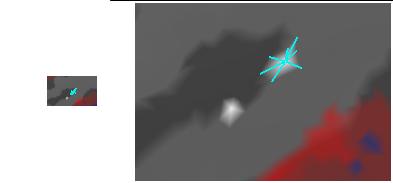General usage
1.0 Quick start
Tksurfer can be started in any of three ways: launching it from FreeSurfer with the Surface button, using the tksurfer-sess script, and calling it from the command line. Depending on which method you use, you may see different types of data loaded, but all methods require a surface data set to be loaded. Other types of data can be loaded from the File menu.
To explore your data, you can move the mouse over the picture of the surface (the Display Window) and see information about the area under the mouse in the window on the bottom (under the Mouse section of the tksurfer Tools Window). You can change the view with the navigation buttons (under the toolbar, with icons of various arrows). To save pictures of your data, go to the Tools menu and select the Save RGB As... item near the bottom.
By default, tksurfer does not redraw the display window unless you perform a command that changes the view. This means that if another window obscures the display window and then is moved, the display window will not automatically update. This because of the time it takes to redraw an average surface. To explicitly redraw the view, just click on the Redraw button.
2.0 Viewing area
Tksurfer consists of two windows. The top window, called the Display Window, shows the currently loaded surface and its overlays. The bottom window, called the Tools Window, contains controls and feedback information. Here is the interface.
Information about the currently displayed data can be obtained by moving the mouse over the Display window or by clicking to select a vertex. As the mouse is moved in the display window, the Mouse section of the Tools window will display information about the vertex under the tip of the Mouse arrow. Information about the vertex clicked on is displayed in the Cursor section.
The view is configured with various dialog boxes and options available from the View menu. From this menu, you can configure the toolbars and labels available in the Tools window, various aspects of the surface, curvature, and overlays, and the time course graph window.
3.0 Navigation
Tksurfer displays the surface in a 3D environment. You may move the surface with the buttons in the movement area of the Tools window.
![]()
The buttons in the left section rotate the hemisphere, the ones in the middle translate it, and the ones on the right zoom in and out. The sliders adjust the number of degrees of each movement. You can also zoom in and out by holding down the control key and clicking with button 1 or 3. Button 1 zooms in, and button 3 zooms out. The vertex you click becomes the center vertex in the new view.
4.0 Cursor and marked vertices
Clicking on a vertex sets the cursor. The edges touching the vertex are drawn in a cyan color.
The cursor is drawn every time the mouse is clicked without redrawing the whole window. However, clicking also marks vertices, adding each clicked vertex to a list of marked ones. These are drawn in a white color, but only show up after the screen is redrawn. This screen shot shows two marked vertices and the cursor, at normal zoom level and zoomed in.

To see this behavior, start tksurfer with any subject and surface. Click with button 1 on the surface and see the cyan cursor appear. Now press the Redraw button (or type Alt+R while the mouse is in the display window) and see the white highlight under it. Now click around some more without hitting redraw and see the cyan cursor move. Now press Redraw ![]() , and see how all the points you previously clicked are drawn in white.
, and see how all the points you previously clicked are drawn in white.
Most tools require at least two marked vertices, and some as many as four. The icons for the cut tools give hints as to how many you need. To clear the marked vertices (unmark them), click with button 3. Note that the white highlights will not disappear until Redraw is pressed.
